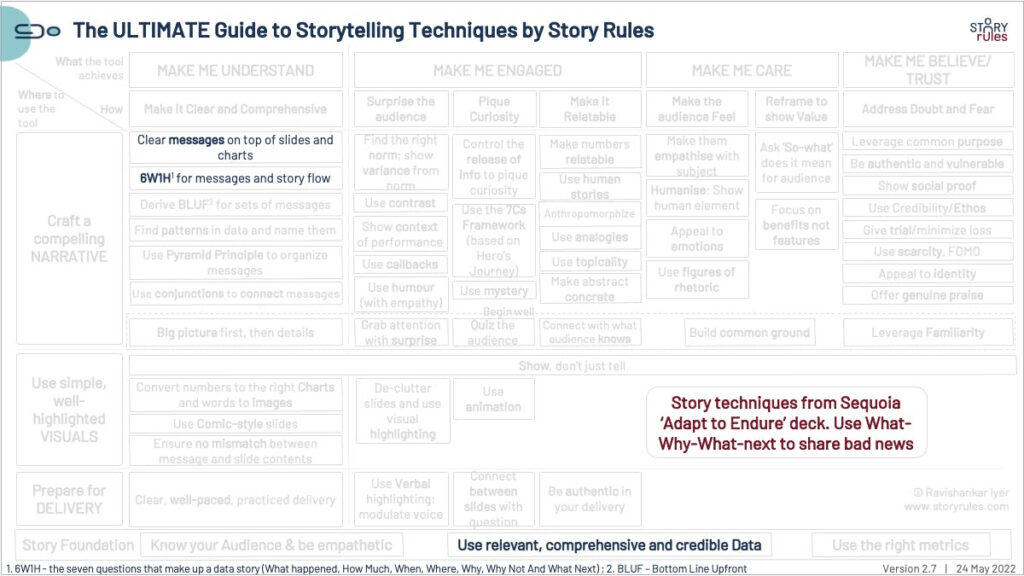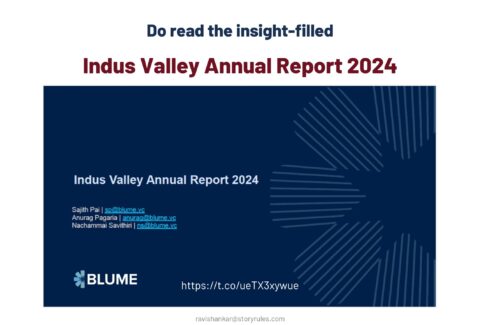#SOTD 69: Don’t hide bad news (Sequoia deck)
June 2, 2022 2023-01-04 18:56#SOTD 69: Don’t hide bad news (Sequoia deck)

#SOTD 69: Don’t hide bad news (Sequoia deck)
Today we look at how the Sequoia deck does not mince words in conveying bad news.
For those who came in late: This week I’m breaking down some of the storytelling techniques used in Sequoia’s recent presentation to its portfolio companies titled ‘Adapting to Endure‘.

To recap:
– In Monday’s email, we looked at how the presenter starts with a personal story – of having faced a similar economic downturn.
– Tuesday’s edition looked at how the deck had clear messages on top of slides and charts.
– On Wednesday we explored the use of the Pyramid Principle to structure your thoughts.
Today’s lesson: The use of a simple story flow (What-Why-What next) and the willingness to lay out the bad news upfront without mincing words.

No wonder, if we have bad news to share at the workplace, we try various tactics to soften (or altogether avoid) the blow. We sugarcoat it or try to give a ‘positive spin’.
Sequoia does none of the above. In a series of messages it lays down the state of the economy and then follows it up with the implications:
- We’re experiencing the 3rd largest Nasdaq drawdown in 20 yrs
- 61% of all software, internet and fintech companies are trading below pre-pandemic 2020 prices
- 1/3 are trading below COVID lows, when uncertainty and fear was peaking
- Growth at all costs is no longer being rewarded
- Focus is shifting to companies with profitability
- Cheap capital is not coming to the rescue
- Medium to long-term: durable growth with improving profitability is always the path
- Recovery will be long
Here’s my interpretation of the overall message they are giving with these key statements:
1. Things are bad:
- We’re experiencing the 3rd largest Nasdaq drawdown in 20 yrs
- 61% of all software, internet and fintech companies are trading below pre-pandemic 2020 prices
- 1/3 are trading below COVID lows, when uncertainty and fear was peaking
2. The party is over:
- Growth at all costs is no longer being rewarded
- Focus is shifting to companies with profitability
3. There will be pain and recovery will be long:
- Cheap capital is not coming to the rescue
- Medium to long-term: durable growth with improving profitability is always the path
- Recovery will be long
Alright what next after these messages? Once having laid out the bad news, the responsibility of the storyteller is to answer two key questions:
- Why did this happen?
- What can we do?
Sequoia answers both these questions (especially the ‘what next’ part) clearly in the deck.
Incidentally, I had mentioned this framework for conveying bad news in an earlier post, using the case study of J&J’s Tylenol, where I argued that in some cases bad news can be good for your brand/ethos.
Don’t hide bad news – be upfront about it, and follow it up with the Why and the What next.
#SOTD 69








